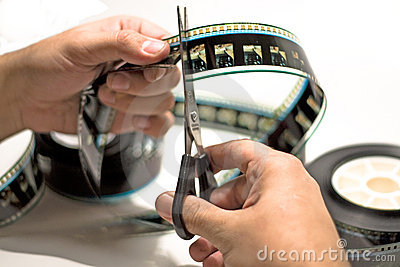- Editing is the process of selecting, arranging, and manipulating footage to create a cohesive and engaging story.
- key terms: shot, cut, sequence, montage, continuity, and pacing.
Continuity Editing: Also known as "invisible editing," this technique aims to maintain a seamless flow of time and space within a scene or sequence. It ensures that the viewer does not notice the cuts between shots, creating a natural and coherent progression. Continuity editing relies on the 180-degree rule and the match on action principle to keep the audience oriented.
Montage Editing: Montage involves the rapid juxtaposition of short shots or images to convey ideas, emotions, or the passage of time. It is often used to compress events or convey a character's transformation. Montage can create an emotional impact by connecting shots thematically rather than sequentially.
Parallel Editing (Cross-Cutting): This technique involves alternating between two or more scenes happening simultaneously in different locations. It builds tension, suspense, or thematic connections by showing events in different places that are related in some way. Parallel editing is commonly used in action sequences, chase scenes, and scenes involving multiple plotlines.
Cutaways and Inserts: Cutaways are shots that interrupt a continuous action to show related information or reactions, often used to emphasize details or provide context. Inserts are close-up shots of specific objects or details to highlight their significance within the narrative.
Jump Cut: A jump cut is a noticeable, abrupt transition between shots of the same subject, often indicating the passing of time or a change in perspective. It can create a jarring effect and draw attention to the editing process.
Match Cut: A match cut creates a visual or thematic connection between two shots by aligning similar shapes, movements, or elements. This technique can suggest a link between different scenes or emphasize a specific concept.
J-Cut: A J-cut is an editing technique in film and video production where the audio from the next scene begins before the corresponding video cut takes place.
L-Cut: An L-cut is another editing technique that involves extending the audio from the current scene into the beginning of the next scene, while the video cuts to the new scene. This results in a situation where the audio from one scene "leads" into the next scene, even though the visuals have changed.
Crossfade (Dissolve): A crossfade involves blending the end of one shot into the beginning of the next, creating a smooth transition between scenes. It can convey a sense of time passing or an emotional connection between shots.
Cut to the Beat (Rhythmic Editing): This technique involves editing shots to match the beat, rhythm, or tempo of the background music. It creates a sense of synchronization between visuals and sound, enhancing the viewing experience.
Split Screen: Split screen divides the frame into two or more sections to show multiple scenes or perspectives simultaneously. It can highlight parallel actions or interactions between characters.
Flashback and Flashforward: Flashbacks show events that occurred before the current time in the narrative, while flashforwards depict events that will happen in the future. These techniques offer insights into characters' backgrounds or future developments.

Comments
Post a Comment